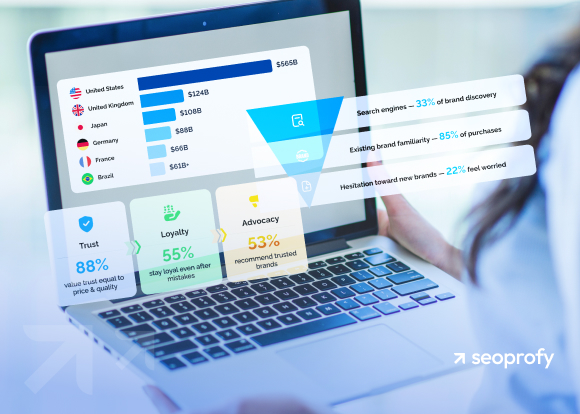In our step-by-step guide, we’ll show you how to create a winning SEO content strategy that not only generates more traffic to your site but also gets you more sales.
Great copy is one of the best ways to draw in more potential customers, build trust, and show your expertise. If you feel like your current efforts don’t really bring any results, then it’s time for a new content marketing strategy for SEO.
- A properly devised SEO content strategy can help attract the right audience and yield higher rankings.
- To make your copy more effective, align it with the search intent and your audience’s needs.
- Covering topics where you have expertise can build authority and make your site a trusted resource.
- Regularly updating content with fresh information and keywords keeps it relevant for readers and search engines.
- Well-placed CTAs encourage readers to take action and can lead to a higher conversion rate.
- Tracking performance metrics helps you see what’s working and make better decisions over time.
What Is an SEO Content Strategy?
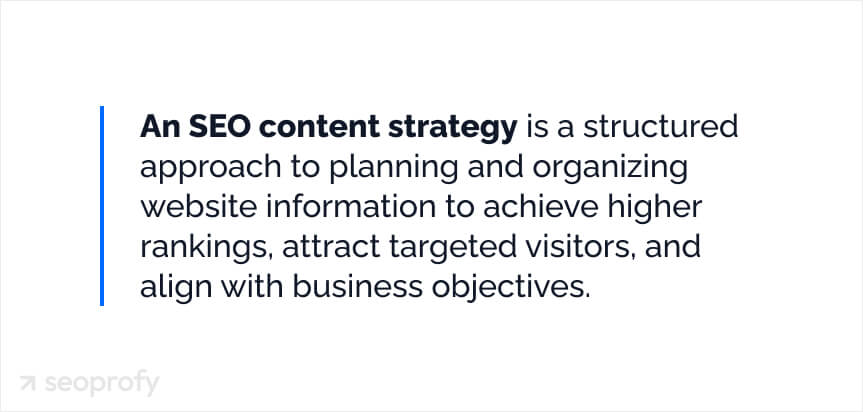
An SEO content strategy is a structured approach to planning and organizing website information to achieve higher rankings, attract targeted visitors, and align with business objectives. But as you probably know, merely churning out content isn’t enough.
You’ll also need to understand which themes will capture your audience’s interest and which phrases will bring in valuable traffic. The goal is to create relevant content for your readers and encourage them to learn more about your offerings—and eventually work with you.
Why Is SEO Content Important for Your Business?
SEO content helps bring in more visitors to your site and also makes your business look more credible. Another big advantage is that it keeps bringing traffic over time without the cost of ads.
And here’s the thing: 70% of internet users prefer to learn about a company through their blog posts.
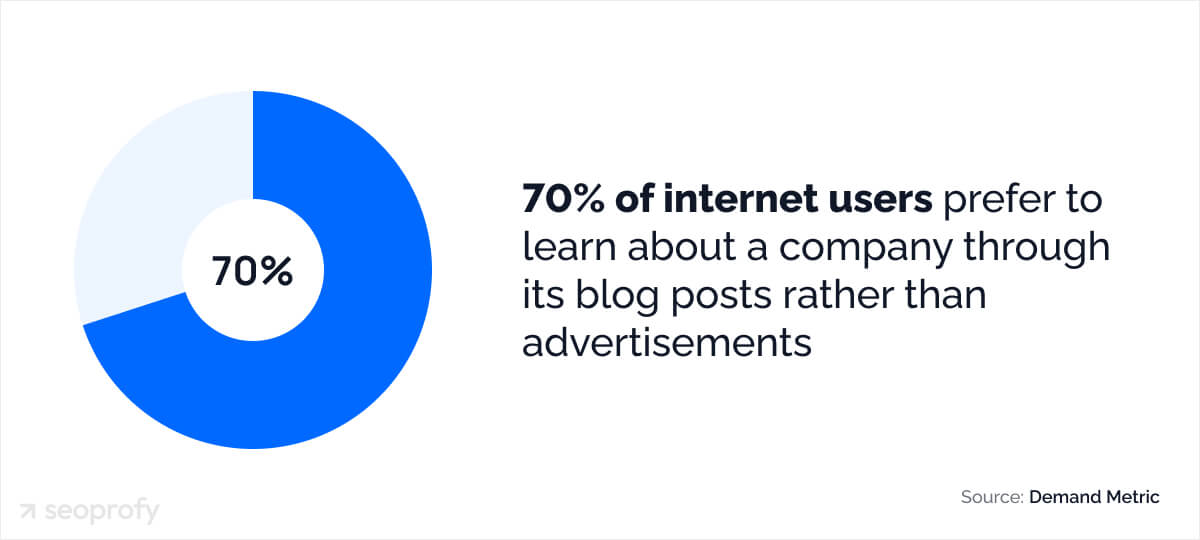
So, the content you create can go a long way in connecting you with the right people and building trust with them. In addition, it can lead to better engagement, more leads, and higher conversions.
How to Create an Effective SEO Content Strategy
From analysis of your potential customers through keyword research to mapping out content topics, here is a guide on how to craft a results-driven strategy:
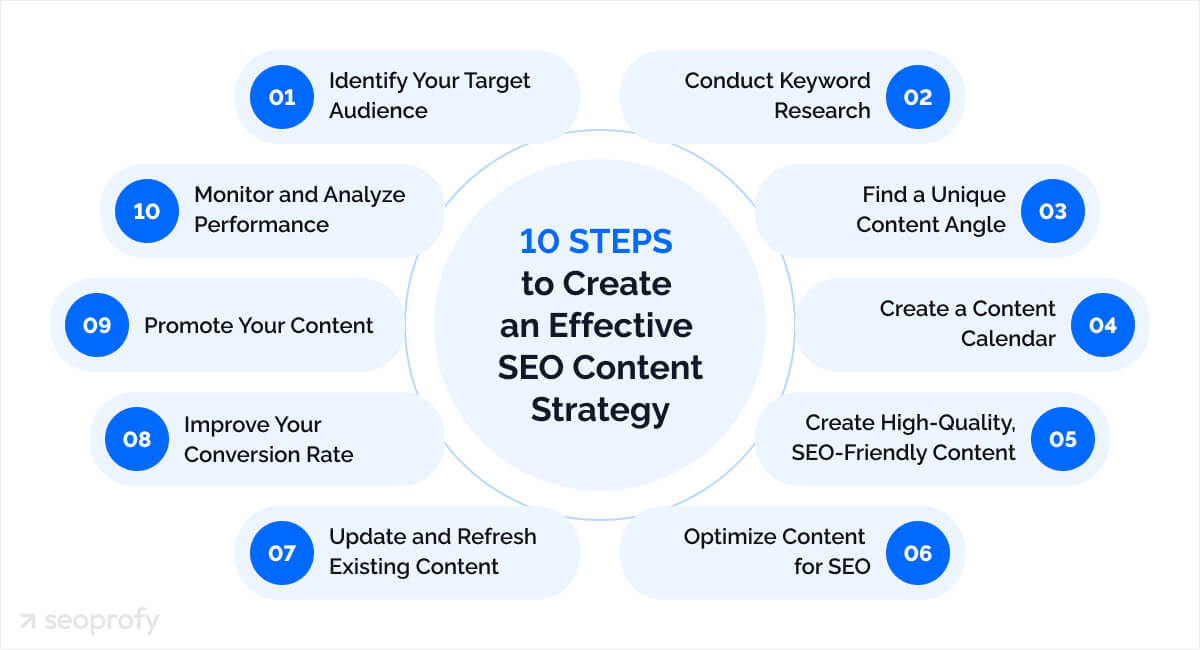
1. Identify Your Target Audience
First, you need to get clear on who you’re creating content for. There are several ways to gather this information:
- Google Analytics: This free tool shows you details about your website visitors, like demographics, interests, and how they interact with your site. You can see which content they engage with most and which topics draw them in.
- Surveys: Use tools like SurveyMonkey to ask your customers directly about their needs and preferences and any other important questions that are relevant to your products or services.
- Audience research tools: Paid options, such as SparkToro, can show you the demographics of your potential customers. Apart from that, you’ll see where they spend their time online, right down to specific sites they visit and social accounts they follow.
2. Conduct Keyword Research
Keyword research is at the core of any successful SEO content strategy. It helps you uncover the exact words and phrases your customers use when searching out your products or services. Following are a few best practices to help you get started:
Start with the Basics
The best way to start keyword research is by brainstorming topic ideas related to your business. Think about what your customers are looking for and what questions they might have. For this, you can type in your seed (main) keyword into a free tool like AnswerThePublic and look at the popular questions and topics people are interested in.
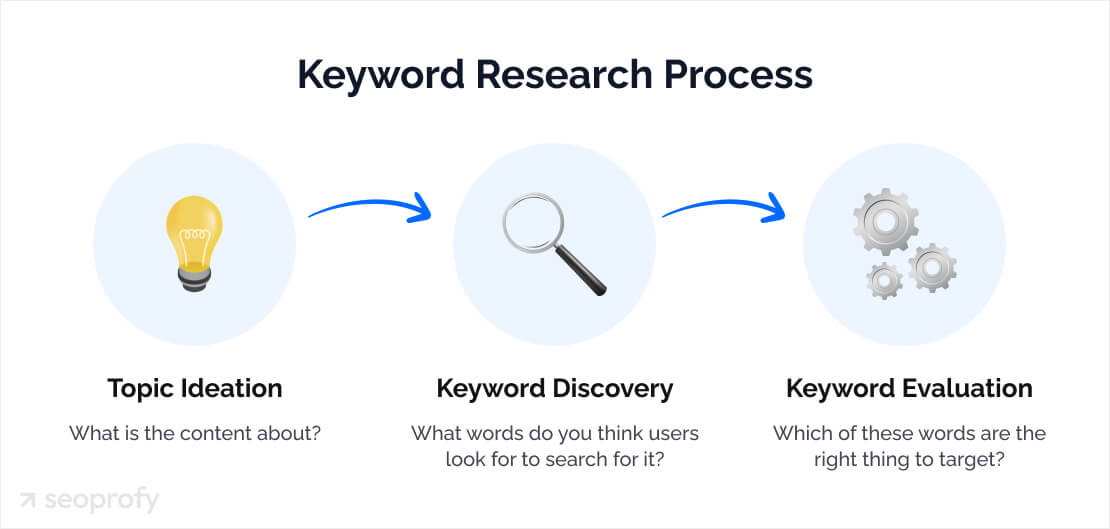
Once you have the list of content ideas for SEO, you can narrow it down to the specific keywords that are most relevant to your audience. Approaching it this way will help you create content that your potential customers are actually searching for.
Check Out Competitor Content
Competitor analysis can be of great help in search engine optimization, especially when it comes to content. It shows you which topics are already working well, so you can focus on similar ones. For this, just type in your competitors’ domain in Ahrefs and navigate to their top pages.
Make note of which content performs well and what keywords they are using. If you’re working in the home goods niche, for example, you might find that a blog post on blanket sizes drives a substantial amount of traffic to a competitor’s site. This insight suggests a potential opportunity to create similar content on your own website, using relevant keywords to attract the same audience.
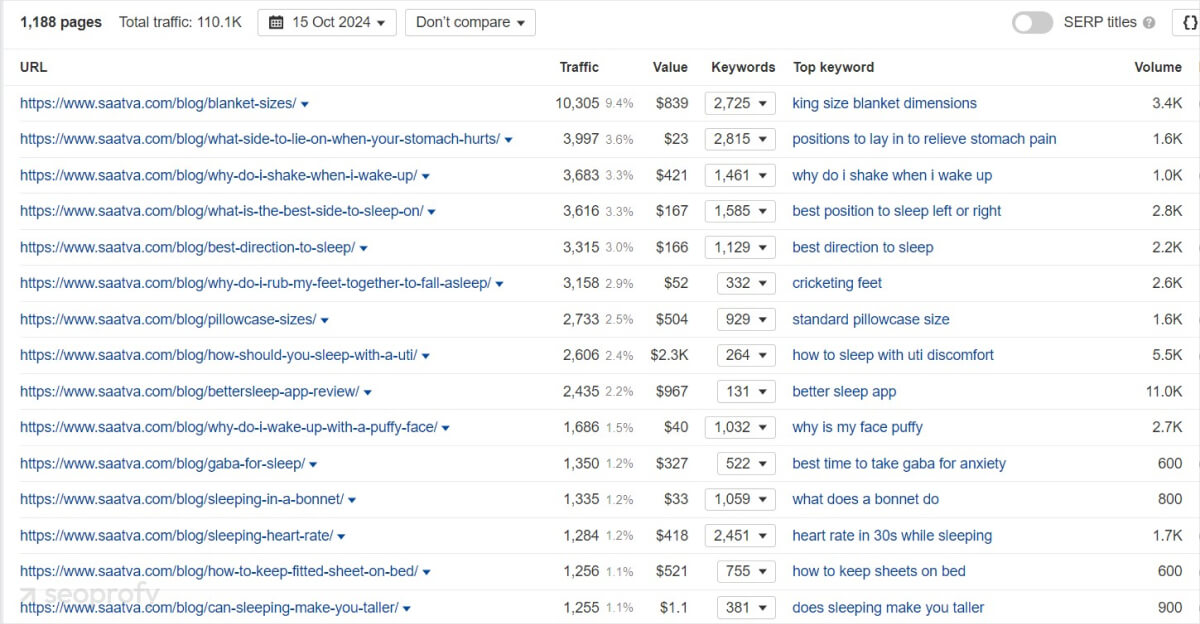
Use Keyword Research Tools
Several tools can make the process of finding keywords easier. However, the best option is Ahrefs Keyword Explorer. It will provide you with more in-depth keyword data, including difficulty scores, SERP features, search volume, and traffic potential. Its “Questions” section is useful, too, because it gives you a list of the content ideas that directly answer what your audience wants to know.
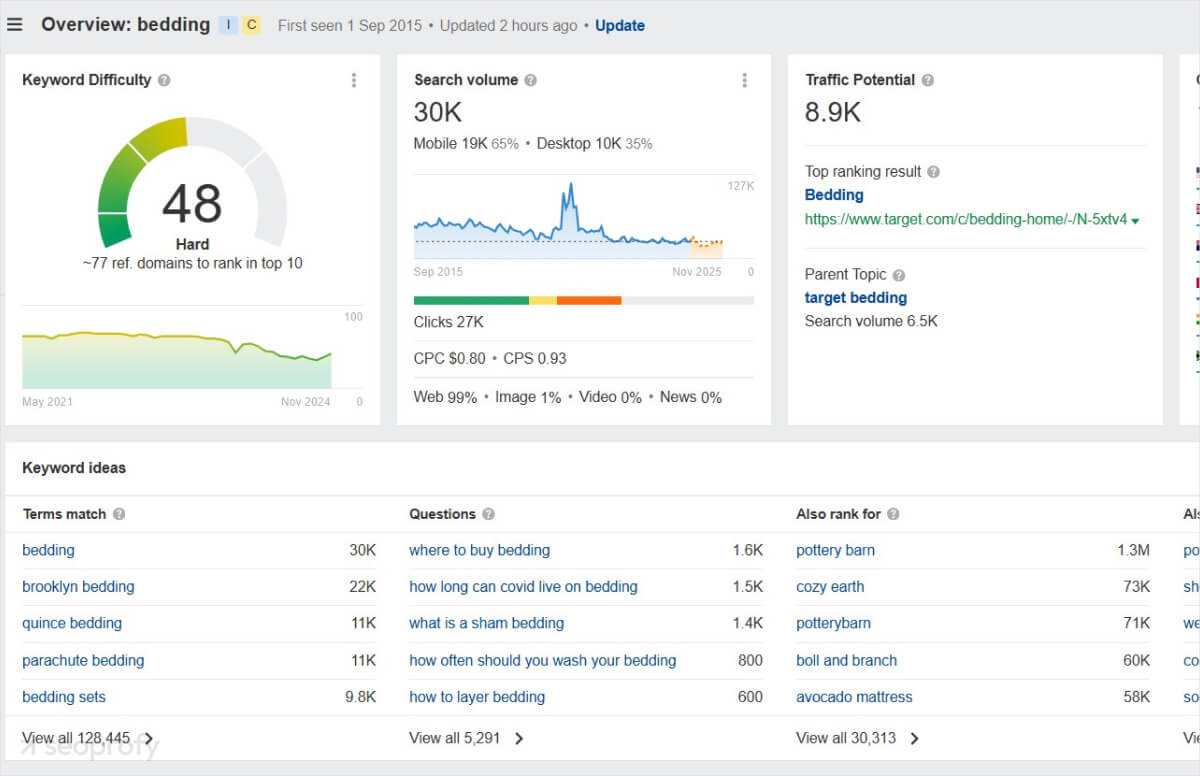
Ahrefs just launched a brand-new feature inside their Keyword Explorer, and now users can filter results based on various use cases. That’s useful if you want to focus on search terms that are trending, low-competition, or likely to show up within featured snippets.
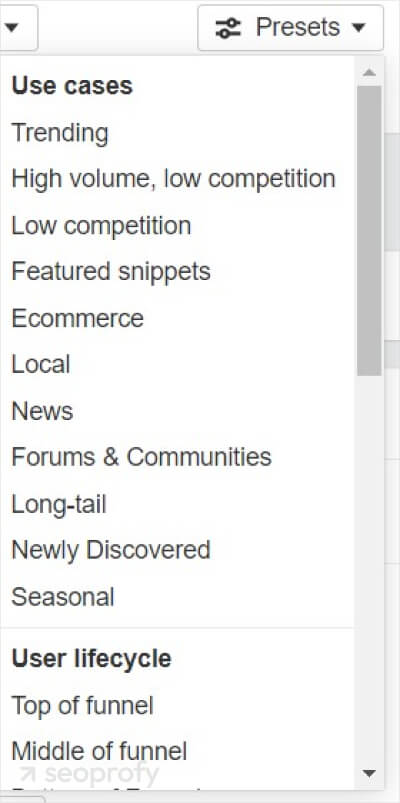
There are also other paid tools like SEMrush, Moz Keyword Explorer, and Ubersuggest that you can try out. All of them are great for keywords research and can give you plenty of ideas in your content strategy for SEO.
Build Topical Authority
Topical authority means covering key areas of your industry well so that search engines recognize your expertise. For example, if you want to create an SEO strategy for a furniture store, use keyword mapping to organize your content around one or two main areas, like sofas or dining tables, instead of trying to cover everything at once.
Once you’ve built up content around these main topics, you can gradually expand into related areas. The more thoroughly you cover a topic, the more trust you build with both search engines and readers, which can help your pages rank higher.
Choose the Right Keywords
Consider search volume and competition when choosing keywords for your SEO content strategy. The tools we mentioned in the previous section will come in useful here, too. Moreover, it is worth scoring the search terms according to how good a match they are with what you offer.
This is known as “business potential,” and it helps you prioritize keywords that are more likely to lead to sales. Here’s how you can think about it:
| Score | What It Means | Example |
| 3 | Your product is the main solution to the searcher’s problem. | “best cooling sheets for summer” – People looking for cooling sheets are directly interested in bedding products, making this a perfect match. |
| 2 | Your product helps, but isn’t the only solution. | “how to sleep better” – Bedding products can help, but there are also other factors like environment and lifestyle. |
| 1 | Your product might be mentioned briefly but isn’t central. | “bedroom decor ideas” – Bedding could be part of the decor, but it’s not the main focus. |
| 0 | Your product doesn’t relate to this topic at all. | “living room furniture” – Not relevant to bedding, so it’s unlikely to drive interest in your products. |
Long-Tail vs Short-Tail Keywords
In your SEO content strategy, aim for a mix of short-tail and long-tail keywords to balance traffic potential and targeting specificity. In the screenshot below, you can see that short-tail keywords, like “best pillow,” tend to have a lot of searches but are highly competitive, so they’re tougher to rank for right away.
On the other hand, long-tail keywords, like “how to wash pillows” or “best pillow for side sleepers,” have lower search volume but are easier to rank for.
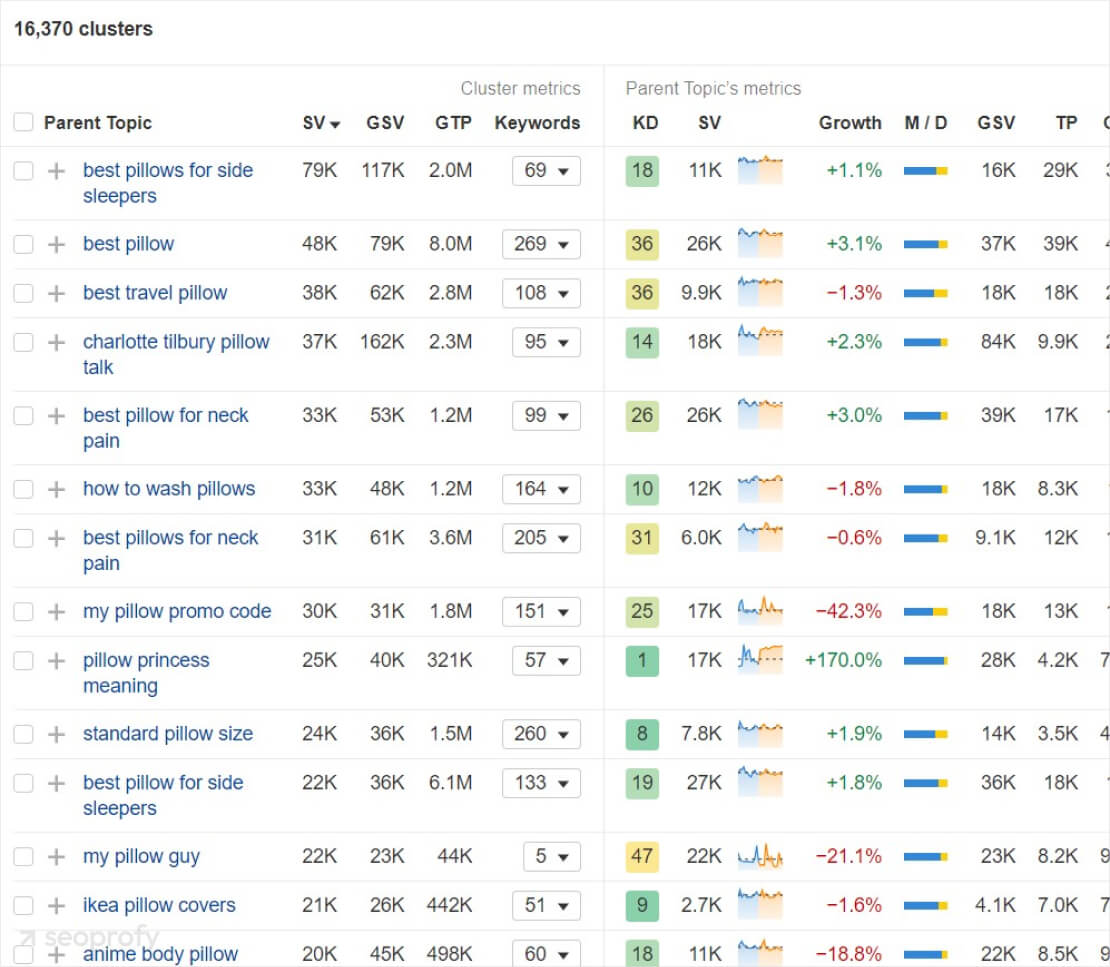
3. Find a Unique Content Angle
When creating a content strategy for SEO, it’s important to find a specific angle or focus. What we mean by this is that rather than trying to cover everything broadly, choose an area where you can provide real expertise.
Think about your unique strengths and the particular needs of your audience. For example, if you specialize in sustainable bedding, then your content might deal more with eco-friendly materials, taking care of natural fabrics, or even the benefits of organic bedding.
By niching down, your content will stand out a lot more and position you as an expert in a certain area, which generally will make attracting a loyal audience who value your specific insights a lot easier.
Once you know your focus, use various content types to keep things interesting and reach different kinds of readers. Here are a few formats you can try:
- Blog posts: These work well if you want to offer detailed information and answer common questions.
- How-to guides: Best format to walk readers through tasks and solve problems that they might have.
- Listicles: Simple, easy-to-read lists often rank well in search engines because they’re straightforward.
- Research reports and studies: Original data and insights are great if you want to offer something new and valuable to your audience. These are also great for getting backlinks.
4. Create a Content Calendar
Organizing your SEO content strategy with a comprehensive content calendar allows you to maintain consistency and align your efforts with broader marketing goals. A well-structured content calendar also helps you publish consistently and improve SEO content by aligning it with seasonal trends and events. Here’s how you can create one for your business:
- Choose a tool for SEO content planning.
- Decide on the types of SEO content you’ll create.
- Determine how often you’ll publish each type of content.
- Include industry events, holidays, and product launches in your calendar.
- Clearly define who is responsible for each piece of content and create a checklist of procedures to track tasks.
- For each content piece, include target keywords and working titles.
5. Create High-Quality, SEO-Friendly Content
Now that you have completed all of the above steps, it’s time to start working on drafting your SEO copy:
Characteristics of SEO-Friendly Content
SEO-friendly content needs to be easy to read, useful, and discoverable by search engines. Here’s how to make sure your copy hits the mark:
- Organized structure: Use clear headings, subheadings, and bullet points to break down information. This makes your content more readable and also helps search engines understand it.
- Relevant visuals: Images, charts, or infographics that relate to your content can increase engagement. Be sure to use descriptive alt texts to improve SEO and accessibility.
Balancing Quality and Keyword Optimization
Your content should flow naturally without any keyword stuffing. So whenever you’re writing your content, try to weave in your main terms organically within headings, the first paragraph, and throughout the text.
You can also use supporting terms and variations known as latent semantic indexing (LSI) to make your text richer and less redundant. Doing so can also help you rank for related terms and attract an even wider audience.
The Importance of Unique and Engaging Content
Content that offers something new keeps your visitors more engaged. Instead of repeating generic information, you can share your fresh take on things and give practical advice relevant to your business.
Our team has experience across many niches and crafts content in over 15 languages. We write copy that both Google and people love. Let’s work together to create a content marketing strategy that will:
- Drive more traffic
- Build trust and authority
- Increase conversions

6. Optimize Content for SEO
To help more people find your website, you’ll want to optimize it for search engines. Here are some simple, practical steps to strengthen your SEO content strategies and get better results:
Use On-Page SEO Techniques
Organize your content with clear headings. Use H1 for your main title on the page and H2, H3, etc., for subheadings. Include relevant keywords in your headers where natural. Here’s an example of how it can look like for an eCommerce article:
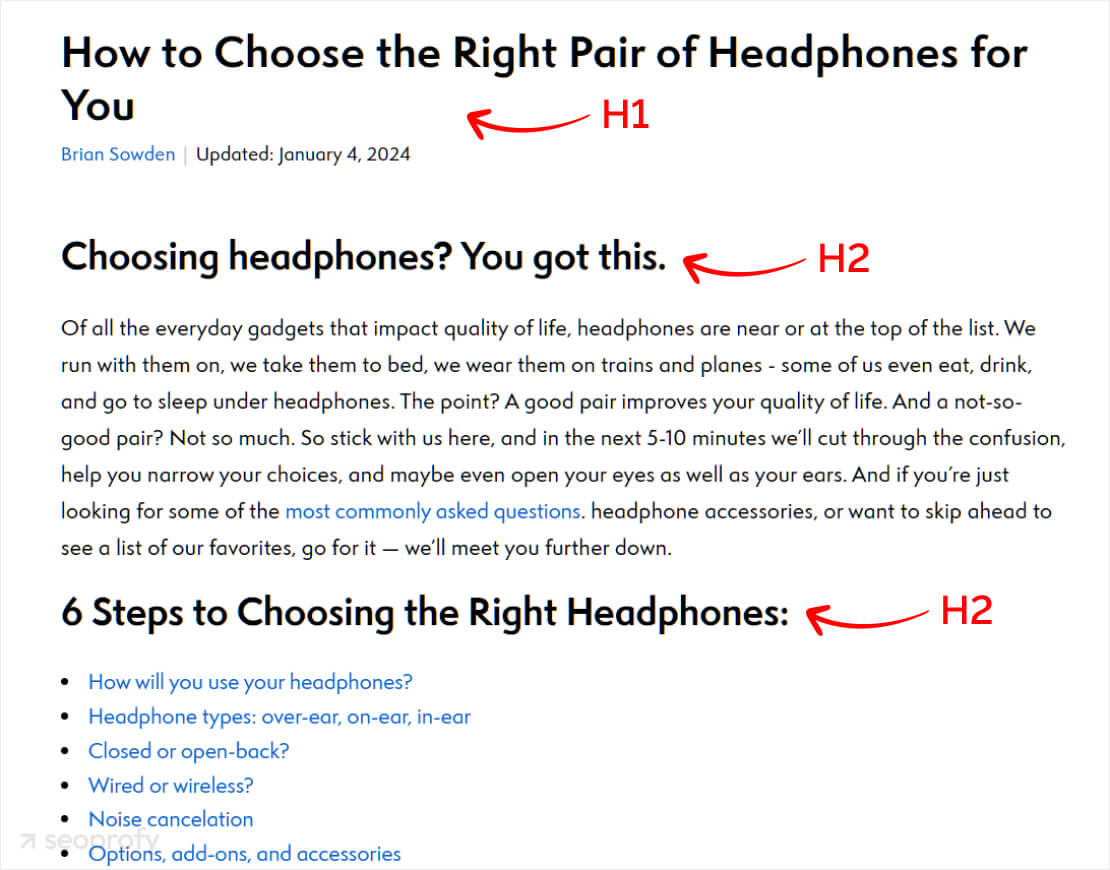
Optimize Meta Tags
- Title tags: Include your primary keyword near the beginning of your title tag. Keep titles under 60 characters to ensure they display fully in search results.
- Meta descriptions: Craft attractive meta descriptions that include your target keyword and encourage clicks. Keep them under 160 characters.
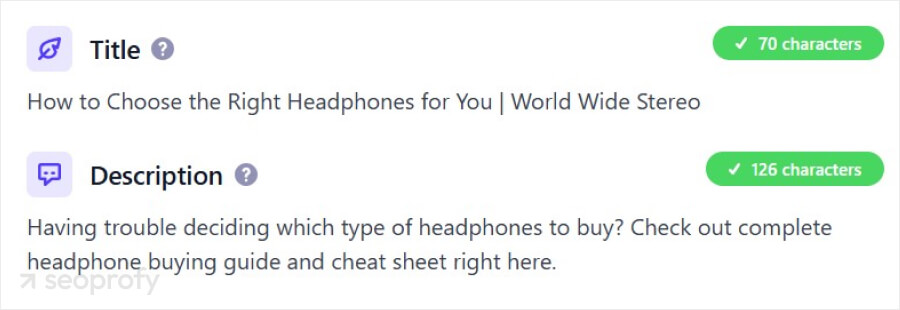
Implement Internal Linking
Create a well-organized internal linking structure that makes it easier for Google to understand your site’s hierarchy and spread link equity. For example, you can link to related blog articles on your site, so the readers can read more on the topic.

7. Update and Refresh Existing Content
Refreshing old articles is one of the easiest ways to improve your website’s performance. Our SEO agency pays special attention to this step as both search engines and readers appreciate up-to-date information.
So, how can you tell which pages need a refresh? You can start with a simple content analysis. For this, navigate to the Performance tab in Google Search Console, compare two date ranges, navigate to “Pages,” and then sort by either clicks or impressions:
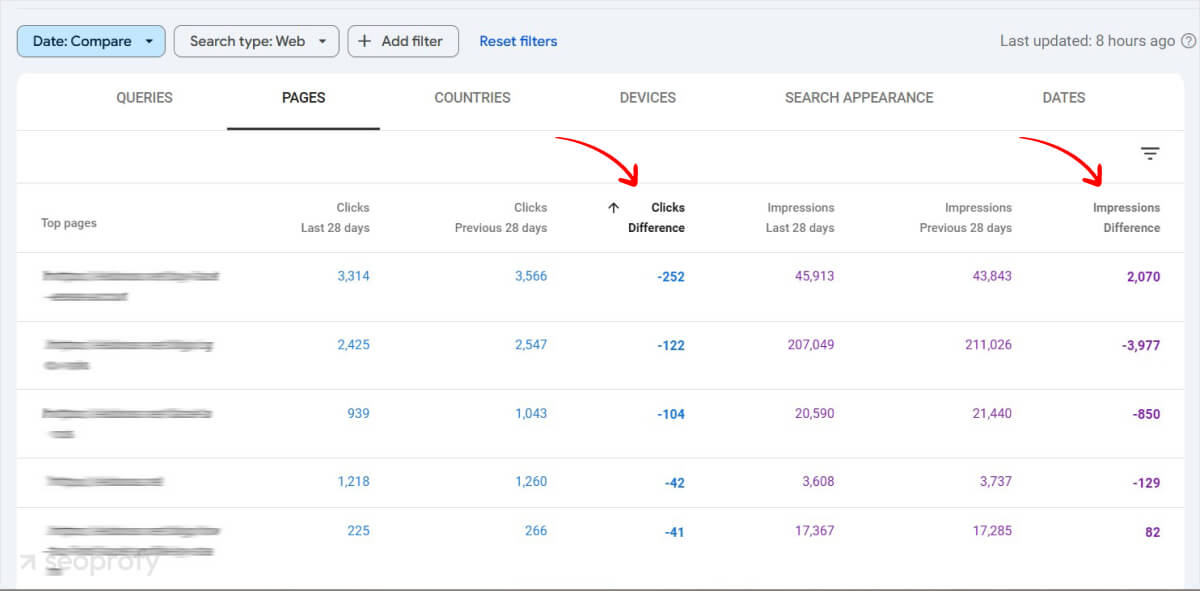
If you want to take it even further, you can use Ahrefs’ Page Explorer and check which of your current pages have a drop in traffic. For this, click on the Advanced filter, set the rule to “Organic traffic” and adjust the operator to “Dropped by at least 10%”.

Once you’ve identified the pages that are underperforming, review them for old facts, broken links, or missing details. Then, add the latest data, update statistics, and include new insights. You can also check if the keywords are still relevant or if they need to be replaced.
8. Improve Your Conversion Rate
At the end of the day, the main goal of any business is to make money. So, for your content marketing strategy to truly work—whether it’s generating leads, sales, or sign-ups—you need to focus on improving your conversion rate.
One effective approach is to use targeted calls-to-action (CTAs) that match the content and the stage of the buyer’s journey. For instance, you can place them where they naturally fit into the user experience, like in the middle of a relevant blog post. Here are a couple of examples:
In our article on how to outsource SEO, we added this CTA section in the middle to guide our users to the next step:
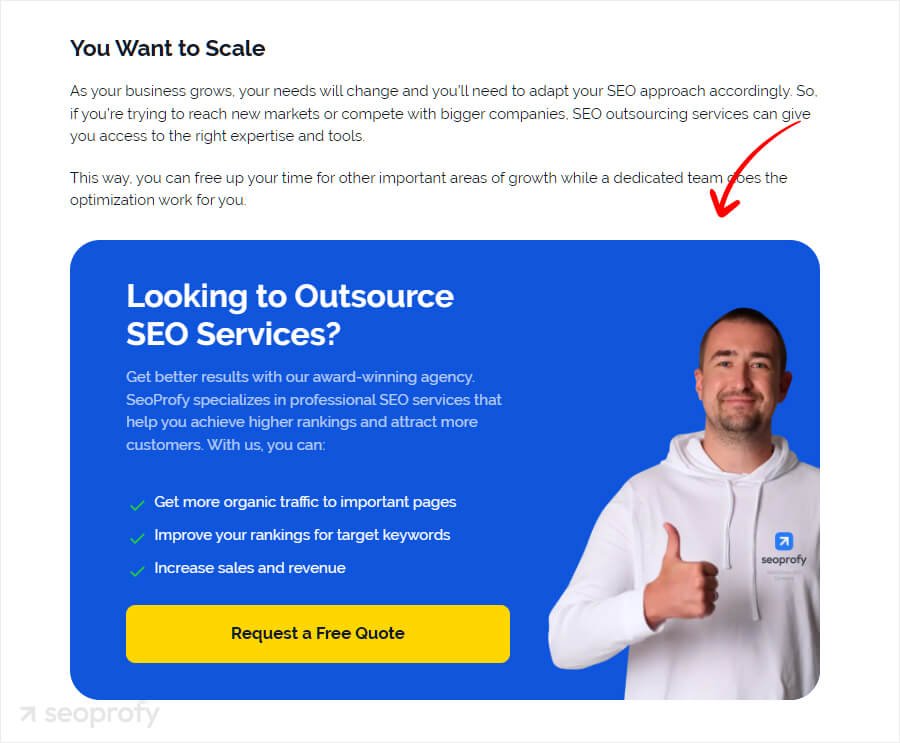
Now, let’s look at the other example below. Here, the button “Book lesson” is located just under the intro paragraph. This works well for the reader’s intent because they are already interested in learning Polish.
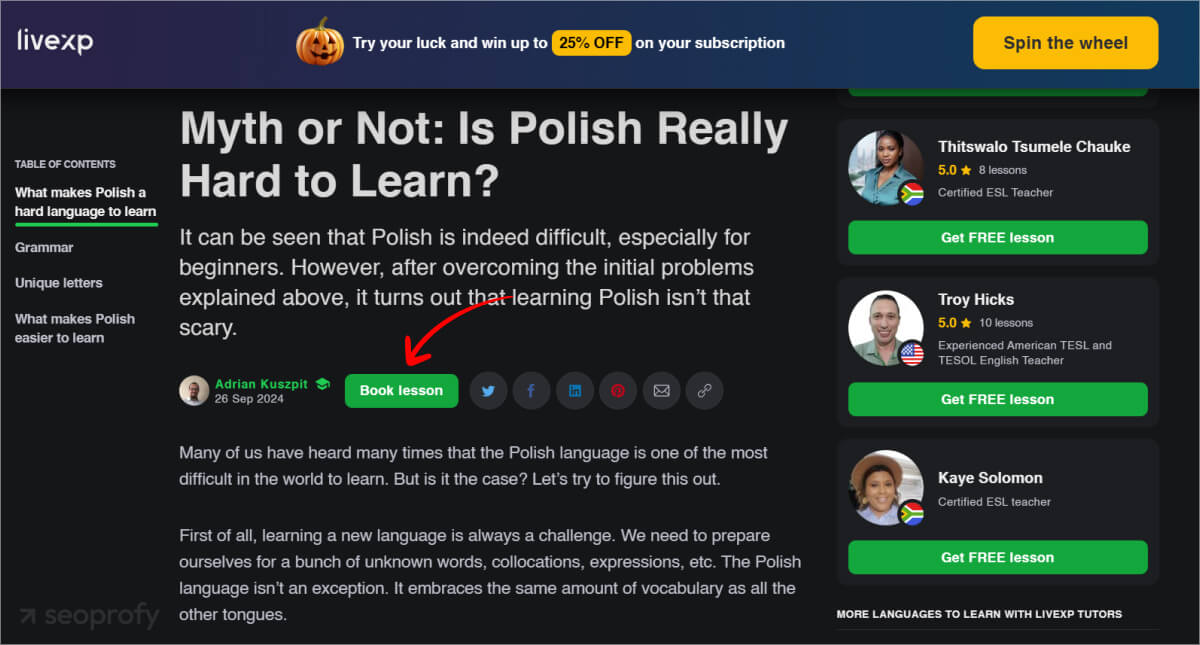
So if you’re getting traffic but no sales from your content, place your CTAs strategically, make them visible, and customize messaging based on user intent.
Important Note: While optimizing for conversions is essential, avoid excessive promotional elements that could compromise user experience. Strike a balance between conversion optimization and content value to maintain user trust and engagement.
9. Promote Your Content
Publishing great content is only half the battle. To maximize its impact, you need to make promotion an important part of your SEO content marketing strategy. Here are some effective ways to do this:
- Social media sharing: Share your content across relevant social platforms, tailoring your message to each platform’s audience.
- Email marketing: Send new content to your email subscribers, segmenting your list for more targeted outreach.
- Outreach and link building: Reach out to industry influencers and relevant websites to share your content and potentially earn backlinks.
- Content repurposing and multilingual SEO: Transform your content into different formats (e.g., turn a blog post into an infographic or video) to reach new audiences on more platforms. You can also localize your content for different regions.
10. Monitor and Analyze Performance
Regularly tracking your content’s SEO performance can allow you to find out what’s not working and refine your SEO content strategy. Use tools like Google Analytics, Google Search Console, and SEO tools (Aherfts, SEMRush, etc.) to monitor:
- Organic traffic: Track the number of visitors coming to your site through organic search.
- Keyword rankings: Monitor how your target keywords are performing in search results.
- Engagement metrics: Analyze metrics like time on page, bounce rate, and pages per session to gauge user engagement.
- Conversions: Track how your content is contributing to your overall business goals.
It’s a good thing to remember that the SEO timeline can vary from business to business and you might not see great results in the first few months. But as your content gets indexed and more people can find it online, you’ll start to see more visitors on your site.
Conclusion
A winning SEO content strategy requires a combination of careful planning, high-quality copy, and ongoing optimization. It ensures that you’re producing valuable and SEO-friendly content that drives more organic traffic to your site, and ultimately boost your sales.
Remember, building a solid SEO and content strategy is a long-term game. Be patient, stay consistent, and focus on providing value to your audience. With time and effort, you’ll see your content strategy pay off.
You don’t have to do everything by yourself. We offer expert SEO content writing services to help you achieve your online marketing goals. Speak to us today!







